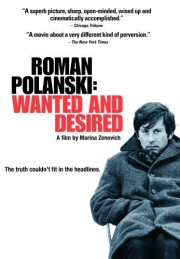 With the temperature dropping, it's time to find someone to keep you warm. Find your hookups with our online dating guide!
With the temperature dropping, it's time to find someone to keep you warm. Find your hookups with our online dating guide!
Wanted and Desired
- Rated NR
- Documentary
- 2008
- DVD
Reviewed by Bob Westal
()
obody does it to you like Roman Polanski!”
– Tagline for “The Tenant”
To a lot of us, Roman Polanski deserves the equivalent of a Nobel Prize for filmmaking, but Roman Polanski is still best known in the United States as – in Polanski’s own words – “an evil, profligate dwarf.” Some of that is because of his darkly puckish public persona, his Polish accent, and, of course, his height. Of course, the main reason is that, roughly 30 years ago, the 45-year-old director fled the country in the wake of an alleged 1977 poolside rape-by-drugging of a very underage teenager at the home of the vacationing Jack Nicholson. Jokes like the one about Polanski’s next movie being “Close Encounters of the Third Grade” aside, the details of the case have inevitably remained murky ever since: only two people in the world really know what happened, both of them were stoned and one of them was only 13 years old. Nevertheless, thanks to a superb piece of investigative filmmaking by documentary filmmaker Marina Zenovich, the facts surrounding the case have, at least, become clearer.
In just over 100 thoroughly engrossing minutes, “Roman Polanski: Wanted and Desired,” manages to tell three separate, but inextricably bound tales. One is the he-said, she-said mystery of just what happened that fateful night in the Hollywood hills between Polanski and young Samantha Geimer; another is the court case resulting from it; and finally the astonishing life story of Polanski – a subject that itself could easily fill several films. It includes a childhood spent fleeing Nazi death camps, and an unlikely, speedy rise from Polish film school to Hollywood’s A-list as a master of psychological horror and suspense. It also includes nearly unendurable tragedy when his pregnant wife, actress Sharon Tate, was killed alongside several of her friends by followers of a sad little racist named Charles Manson.
Horrifically, the press initially made a prime suspect of Polanski. To the media of his day, any guy who could so effectively create the satanic evil doings of “Rosemary’s Baby” and creep out an entire nation was likely capable of just about anything – especially with that funny foreign accent of his. Though he was visibly devastated by the crime, Polanski received little public sympathy after the facts became clear.
In the DVD commentary, director Zenovich comments that the case has two victims. The first is obviously the actual victim in the rape case, the now-middle-aged Samantha Geimer, who emerges as a likable, outspoken woman; the second is Polanski. It also, she says, has two perpetrators. The first is, again, Polanski, who at the very least admits to knowingly having sex (the charges included “sodomy”) with a 13-year-old girl, and giving her champagne and part of a Quaalude, a downer that was a near-ubiquitous party drug at the time. The second perp, however, turns out to be the judge in the case: Laurence Rittenband. His inappropriate, ego-fueled anger at Polanski apparently had nothing to do with the charges themselves. Instead, they seem to have had everything to do with his apparent need for attention and validation when it came to celebrity-driven cases, and resulted in Polanski receiving the legal equivalent of a rape, but not justice.
Refreshingly, however, Zenovich also provides two heroes – Lincoln-esque defense attorney Douglas Dalton, and Roger Gunson, an ultra-straight arrow prosecutor who, at the time of the case, was a near dead-ringer for Robert Redford. A devout Mormon, he also earns this cinephile’s respect for taking the trouble to watch all of Polanski’s far from family-friendly films at a retrospective that was being held at West Los Angeles’s Nuart Theater.
As the film wears on, it elicits not only an increasing measure of respect for the two honest lawyers, but also creates a constant tension between the crime in question and Polanski’s many admirable traits. The question of the severity of the crime is muddied by strikingly different cultural attitudes between Americans and Europeans toward underage sex. (Geimer had a sexual relationship prior to her encounter with Polanski – a fact that may be considered inappropriate to even mention in the U.S., but is brought up fairly often by Europeans.)
Zenovich, an American woman with deep roots in Europe, is probably the absolute best filmmaker to try to unravel this case, and she does about the best job imaginable. It’s easily one of the strongest films ever made about the ins-and-outs of American jurisprudence, and would make a great double bill with Barbet Schroeder’s 1990 docudrama “Reversal of Fortune,” about the equally convoluted Claus von Bülow affair.
If anybody gets short shrift in Zenovich’s film, it is Judge Rittenband, who died in 1994. An avid schmoozer at the show-biz-centric Hillcrest Country Club, and himself attracted to much younger women (though always above legal age, of course), he was probably a charming man in most situations. Unlike Polanski, however, he doesn’t appear to have a huge number of loyal friends alive and ready to speak up for him on camera. Even among the very few people on view who had good relations with Rittenband, one former D.A. admits to a serious breach of legal ethics that has actually sparked new proceedings since Zenovich’s film was released in theaters and shown on HBO. Trials by cinema can never really be fair, but the evidence here looks kind of damning.
Though it is highly entertaining and surprisingly emotional, the key words I’d use to describe “Roman Polanski: Wanted and Desired” are “judicious” and “dispassionate” (which, as all English majors know, does not mean “lacking passion”). It earns its feelings through a careful collation of the facts, presented at a steady but highly watchable pace. It is a huge feat of cinematic concision, but also a deeply humanistic view of two thoroughly honorable lawyers (they exist!), one curmudgeonly judge, and, finally, two indomitable survivors.
Single-Disc DVD Review:
You really could not ask for anything more than this DVD provides. Along with some very brief deleted scenes, it provides two hours of fascinating additional interviews. Watching them reveals just how carefully director Zenovich and editor Joe Bini tried to ensure that the film neither excessively praised Polanski as an artist, nor excessively damned the hard-to-like Judge Rittenband. They also exercised laudable restraint in leaving out interesting but not-quite-relevant memories from some of Polanski’s best known friends, including producer Robert Evans and “Chinatown” screenwriter Robert Towne. (For the sake of marketing alone, others would almost certainly have worked them in regardless of content.) There is also an engaging and good-humored commentary with Zenovich and Bini, her editorial collaborator and co-writer. Highly recommended.
You can follow us on Twitter and Facebook for content updates. Also, sign up for our email list for weekly updates and check us out on Google+ as well.











